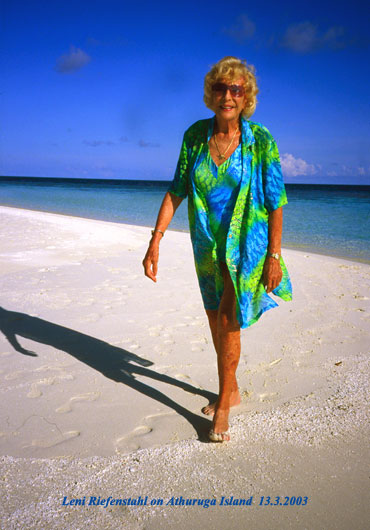
Leni Riefenstahl was born in Berling on August 22nd, 1902. As a child, she studied painting and took up dancing, quickly becoming famous after her first performance when Max Reinhardt recruited her for the "Deutsches Theater." After a knee injury, she moved on to film and became widely known for her roles in the films »Der heilige Berg« (1926), »Der große Sprung« (1927), »Die weiße Hölle vom Piz Palü« (1929), »Stürme über dem Mont Blanc« (1930), »Der weiße Rausch« (1931), »Das Blaue Licht« (1932, which she directed) and «SOS Eisberg» (1933). Leni directed a total of eight films in her career, including, notably, Triumph des Willens (1935), named after the Reich Party Congress 1934 in Nuremberg. It received the gold medal in Venice in 1935 and the gold medal at the World Exhibition in Paris in 1937. Unfortunately, once the war ended, Leni's career as a film director was effectively destroyed as her films were no longer seen as art but as propaganda.

Leni also had an extremely successful career as a photographer, for which she gained fame after her visit with the Nuba. Her photographs were published in the magazines »Stern«, »The Sunday Times Magazine«, »Paris Match«, »L'Europeo«, »Newsweek« and »The Sun«. She also published illustrated books »The Nuba« and »The Nuba of Kau«, which earned her further honors and awards. You can see a bunch of her photos here.

At the age of 71, Leni took up diving and began underwater photography, publishing two more books, "The Coral Gardens" and "The Wonders Under Water," receiving yet further honors and awards for them. In 1987, she published her "Memoirs", after which she continued underwater photography. In 2000 she returned to Sudan to visit her beloved Nuba, but her trip was cut short as she was forced to leave the mountains by helicopter. The helicopter crashed with no deaths and a few injuries, but Leni was taken to a German hospital where they found that she had suffered a number of rib fractures and damaged her lungs. Despite this, she continued her ambitions afterwards and lived to the ripe old age of 101.

That's crazy! What an driven woman. It's interesting that she created propaganda films, and yet "love the nuba," a child clearly not of the aryan race which she helped promote the 'superiority' of.
ReplyDeleteI was thinking that myself. She seems to be, from what I read, a much beloved character in history, despite the momentary hate. Momentary but monumental, I guess. It seems like something she will never be forgiven for. I wondered in my research whether she was truly interested as the Nuba as a people or as a subject, however. Were they equals living in a different kind of society, or were they more like animals in a zoo to her?
DeleteI feel like any film, especially documentaries, if taken out of social context, can come across as propaganda. Even something as innocuous as March of the Penguins could be taken out of context to be a propaganda film for environmentalists.
ReplyDelete